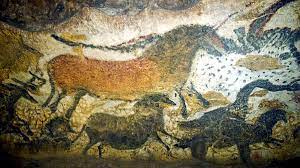2.6 million – 12,000 years ago
Men and women would draw pictures of themselves and animals around them and, in the latter part of the period, they also drew crazy creations of half-human half-beasts!
The Palaeolithic period (sometimes called the Stone Ages) is the earliest that humans lived on Earth.
In fact, this period is so long that it covers about 99% of all human history!
In this prehistoric stretch, men and women would use the rocks around them to create dark-coloured paints to decorate caves with! Different rocks can be ground up to make different colours.
The black colour you see on cave paintings is made by grinding up charcoal (just like the stuff you might use on a barbecue) and mixing it with water.
The mixture will then be warmed up so the water evaporates, leaving behind a handy, black paste!
Minerals were also used for painting with.
Minerals are naturally occurring substances that are found all over the earth. Every mineral is made of a specific mix of chemical elements which ‘grow’ as crystals.
They’re substances that have never been alive – so unlike things like charcoal, aren’t formed from old plants and animals.
Red is made by crushing ochre – a type of earth that’s rich in iron oxide. Iron oxide is what you get when iron and oxygen mix – creating the red colour of rusty metal.
It’s not just water that might be used to form a paste. Men and women would also use plant sap or even spit to make the stuff gloopy enough to stick on the wall!
Let’s see what colours we can make from these minerals…
- Haematite – this is what gives the mineral ochre its reddish colour.
- Limonite – if you see a craggy yellow rock, chances are it’s limonite! This is used to make yellow.
- Limestone – this is what the White Cliffs of Dover are made of and makes…. well, white!
- Manganite – you can make some cool browns with this!
- Pyrolusite – this mineral can also be used to make black.
But what about blue and green? Well, the minerals and chemicals that make those colours are pretty rare. That’s why you don’t get many blue and green cave paintings!
Unfortunately, most cave paintings haven’t stood the test of time. The best examples are found in very dry countries, which is why we don’t have many in Britain!
Another reason why cave paintings disappear is due to people.
Visitors to caves bring moisture in with them, which means fungus, bacteria and moulds can grow – just like you might see on a loaf of bread that’s a few weeks old!
The picture above is from Lascaux, a complex web of caves in south western France.
There have been cave paintings at Lasceaux in France for 17,000 years but they’ve been seriously damaged by bacteria brought in by visitors over the last 100 years. It’s got so bad recently that it isn’t even safe to go in the caves now.
Right, let’s head to Ancient Egypt to explore our next period of art history…




